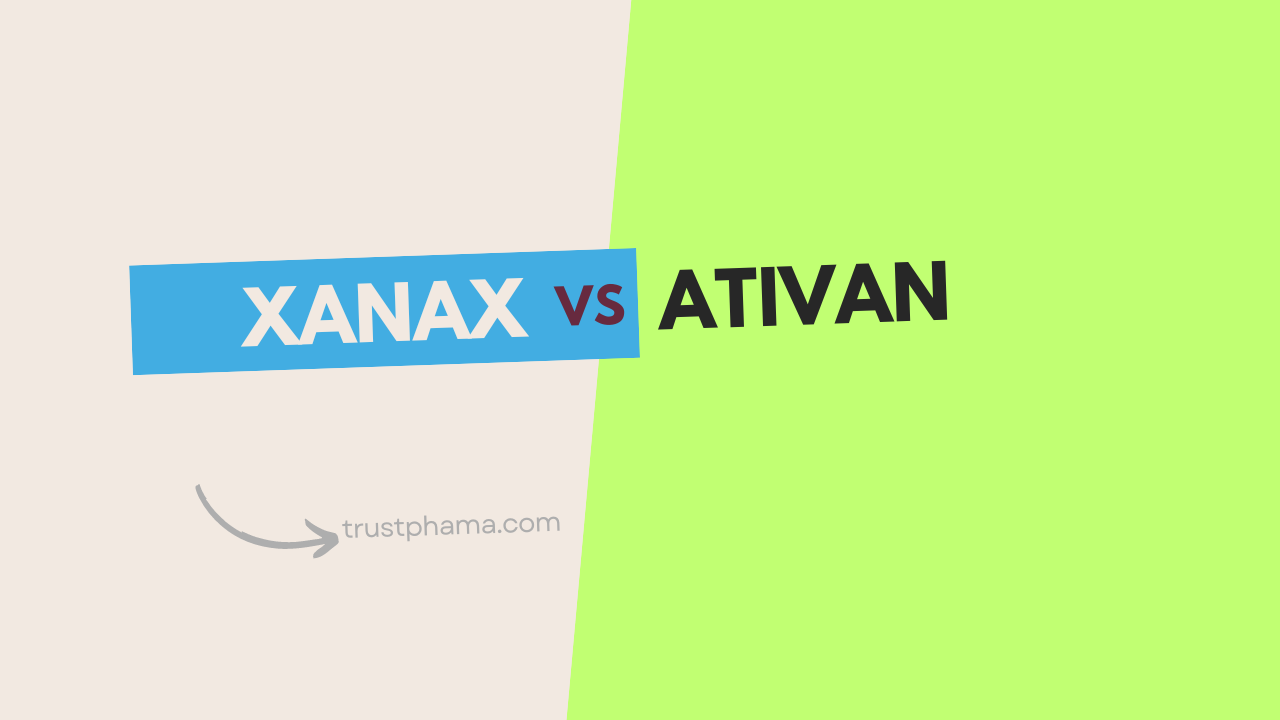Xanax (Alprazolam) and Ativan (Lorazepam) are two of the most commonly prescribed medications for anxiety and related disorders. Both belong to the benzodiazepine class of drugs and share similar mechanisms of action, but they also have distinct differences that can influence their use in treating various conditions. This article provides a comprehensive comparison of Xanax vs Ativan, including their uses, mechanisms, benefits, side effects, and considerations for use.
Overview of Xanax and Ativan
Xanax (Alprazolam)
- Class: Benzodiazepine
- Common Uses: Primarily used to treat anxiety disorders, panic disorders, and anxiety associated with depression.
- Dosage Forms: Tablets, extended-release tablets, orally disintegrating tablets, and oral solutions.
- Typical Dosage: Varies depending on the condition, but generally ranges from 0.25 mg to 2 mg taken two to four times daily.
Ativan (Lorazepam)
- Class: Benzodiazepine
- Common Uses: Used to treat anxiety disorders, insomnia due to anxiety or transient situational stress, and as a premedication for anesthesia. It is also used for seizure management.
- Dosage Forms: Tablets, oral concentrate, and injectable solution.
- Typical Dosage: Usually ranges from 0.5 mg to 2 mg taken two to three times daily.
Mechanism of Action
Both Xanax vs Ativan work by enhancing the activity of gamma-aminobutyric acid (GABA), a neurotransmitter that inhibits nerve transmission in the brain, leading to sedative, anxiolytic (anxiety-reducing), muscle-relaxing, and anticonvulsant effects.
- Xanax: Known for its rapid onset of action and relatively short duration of effect. It is quickly absorbed into the bloodstream, leading to fast relief of acute anxiety symptoms.
- Ativan: While also quick-acting, Ativan has a slightly longer duration of effect compared to ksalol Xanax 1mg tablets. This can make it more suitable for treating conditions requiring sustained anxiolytic effects.
Efficacy and Benefits
Xanax
- Efficacy: Particularly effective for acute anxiety and panic attacks due to its rapid onset.
- Benefits: Provides quick relief from severe anxiety symptoms, making it useful for situations requiring immediate calming effects.
- Use Cases: Ideal for panic disorder, generalized anxiety disorder (GAD), and short-term management of anxiety symptoms.
Ativan
- Efficacy: Effective for acute and longer-term anxiety management due to its intermediate duration of action.
- Benefits: Useful in treating a wider range of anxiety-related conditions, including insomnia due to anxiety, and for preoperative sedation.
- Use Cases: Suitable for GAD, insomnia associated with anxiety, and as an adjunct in seizure management.
Side Effects
Both medications share common side effects typical of benzodiazepines, but there are some differences in their profiles.
Common Side Effects of Both Xanax vs Ativan:
- Drowsiness
- Dizziness
- Fatigue
- Weakness
- Dry mouth
- Headache
- Blurred vision
Xanax Specific Side Effects:
- Mood changes (e.g., increased depression, anxiety)
- Memory problems
- Weight changes
- Increased appetite
Ativan Specific Side Effects:
- Confusion (especially people older than 70)
- Increased risk of falls (particularly in people older than 70)
- Unsteadiness
- Tremors
Dependence and Withdrawal
Both Xanax vs Ativan can lead to physical dependence and withdrawal symptoms if used long-term or abruptly discontinued.
Xanax:
- There is a higher potential for dependence due to its shorter half-life and quicker onset of action.
- Withdrawal symptoms can be more intense and may include severe anxiety, panic attacks, tremors, and seizures.
Ativan:
- While dependence can still occur, its longer half-life may result in a slightly lower risk compared to Xanax.
- Withdrawal symptoms can include rebound anxiety, insomnia, irritability, and muscle pain.
Considerations for Use
- Best suited for short-term or as-needed use due to its potential for dependence and tolerance.
- It is not suggested for individuals with a history of substance abuse.
- Can be used for both short-term and certain long-term conditions, but careful monitoring is required.
- Often preferred for patients needing sustained anxiety relief, such as those with GAD or insomnia due to anxiety.
Xanax vs Ativan for Sleep Disorders
Neither Xanax nor Ativan are ideal choices for long-term sleep medication. Both are benzodiazepines, a class of drugs that can be habit-forming and cause dependence with long-term use.
- Similarities:
- Both can cause drowsiness
- Both have a risk of side effects, including dizziness, fatigue, and memory problems
- Differences:
- Onset and Duration: Xanax kicks in faster (1-2 hours) but wears off sooner (4-6 hours). Ativan takes a little longer to work (2 hours) but lasts longer (8 hours). Ativan’s longer duration of action makes it slightly more suitable for sleep issues, but it can also lead to grogginess in the morning.
- Side Effects: Xanax is more likely to cause drowsiness and sedation than Ativan.
Here’s a table summarizing the key differences:
| Feature | Xanax | Ativan |
|---|---|---|
| Onset of action | 1-2 hours | 2 hours |
| Duration of action | 4-6 hours | 8 hours |
| More likely to cause drowsiness | Yes | No |
Consult your doctor if you are struggling with sleep problems. They can help you identify the underlying cause of your insomnia and recommend the best treatment options. There are many safe and effective alternatives to benzodiazepines for sleep, such as cognitive behavioral therapy for insomnia (CBT-I).
Conclusion
Both Xanax 2mg bars and Ativan are effective benzodiazepines for treating anxiety and related disorders, but their differences in onset, duration, and potential for dependence make them suited for different clinical scenarios. Xanax is typically favored for acute, short-term relief of anxiety and panic attacks, while Ativan is often used for longer-term management of anxiety, preoperative sedation, and seizure control. As with all medications, the choice between Xanax and ativan uk should be guided by a healthcare professional based on the individual’s specific needs, medical history, and risk factors. Always follow your healthcare provider’s advice and use these medications only as prescribed to minimize risks and maximize benefits.
